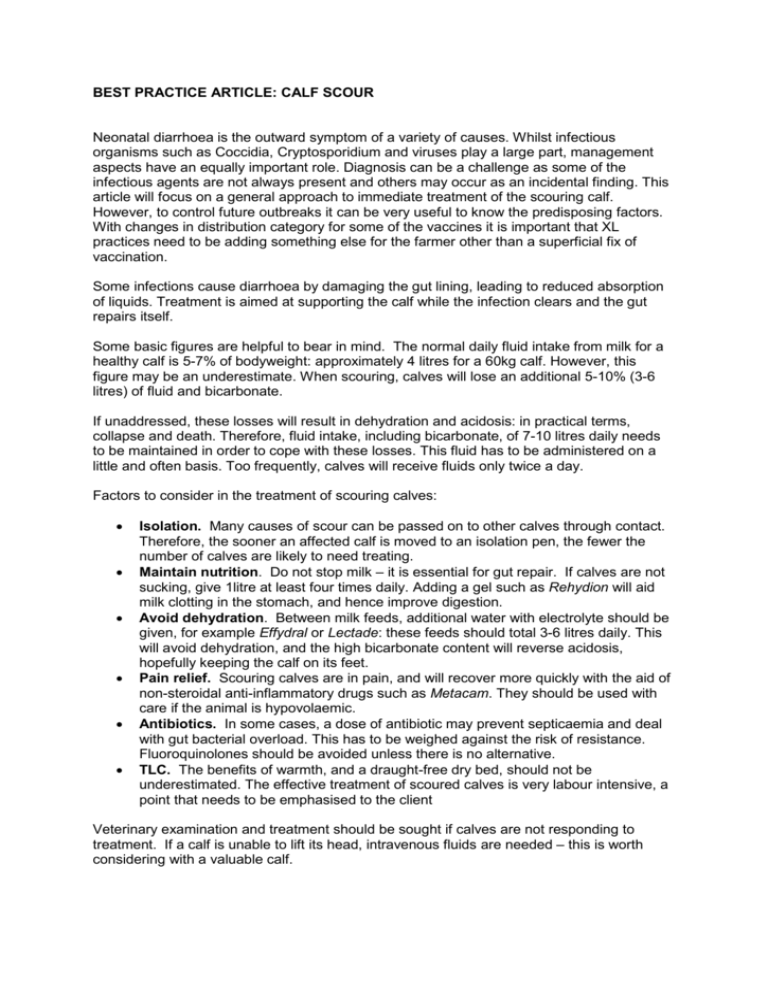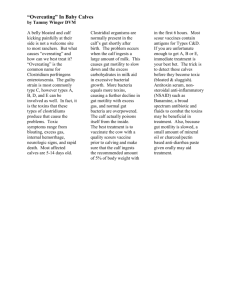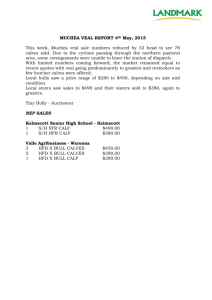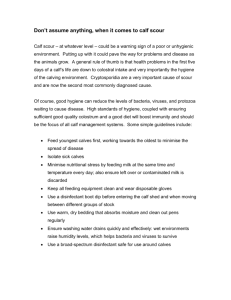BPA-2011-March-Calf Scour
advertisement

BEST PRACTICE ARTICLE: CALF SCOUR Neonatal diarrhoea is the outward symptom of a variety of causes. Whilst infectious organisms such as Coccidia, Cryptosporidium and viruses play a large part, management aspects have an equally important role. Diagnosis can be a challenge as some of the infectious agents are not always present and others may occur as an incidental finding. This article will focus on a general approach to immediate treatment of the scouring calf. However, to control future outbreaks it can be very useful to know the predisposing factors. With changes in distribution category for some of the vaccines it is important that XL practices need to be adding something else for the farmer other than a superficial fix of vaccination. Some infections cause diarrhoea by damaging the gut lining, leading to reduced absorption of liquids. Treatment is aimed at supporting the calf while the infection clears and the gut repairs itself. Some basic figures are helpful to bear in mind. The normal daily fluid intake from milk for a healthy calf is 5-7% of bodyweight: approximately 4 litres for a 60kg calf. However, this figure may be an underestimate. When scouring, calves will lose an additional 5-10% (3-6 litres) of fluid and bicarbonate. If unaddressed, these losses will result in dehydration and acidosis: in practical terms, collapse and death. Therefore, fluid intake, including bicarbonate, of 7-10 litres daily needs to be maintained in order to cope with these losses. This fluid has to be administered on a little and often basis. Too frequently, calves will receive fluids only twice a day. Factors to consider in the treatment of scouring calves: Isolation. Many causes of scour can be passed on to other calves through contact. Therefore, the sooner an affected calf is moved to an isolation pen, the fewer the number of calves are likely to need treating. Maintain nutrition. Do not stop milk – it is essential for gut repair. If calves are not sucking, give 1litre at least four times daily. Adding a gel such as Rehydion will aid milk clotting in the stomach, and hence improve digestion. Avoid dehydration. Between milk feeds, additional water with electrolyte should be given, for example Effydral or Lectade: these feeds should total 3-6 litres daily. This will avoid dehydration, and the high bicarbonate content will reverse acidosis, hopefully keeping the calf on its feet. Pain relief. Scouring calves are in pain, and will recover more quickly with the aid of non-steroidal anti-inflammatory drugs such as Metacam. They should be used with care if the animal is hypovolaemic. Antibiotics. In some cases, a dose of antibiotic may prevent septicaemia and deal with gut bacterial overload. This has to be weighed against the risk of resistance. Fluoroquinolones should be avoided unless there is no alternative. TLC. The benefits of warmth, and a draught-free dry bed, should not be underestimated. The effective treatment of scoured calves is very labour intensive, a point that needs to be emphasised to the client Veterinary examination and treatment should be sought if calves are not responding to treatment. If a calf is unable to lift its head, intravenous fluids are needed – this is worth considering with a valuable calf. Follow up A farmer asking for scour treatment is an excellent point to start a farm investigation. A farm visit should look at all aspects of calf management, from colostrum to bedding. For example if there is insufficient feed for the calf, is it surprising that they will eat their own bedding thereby increasing the risk of coccidiosis? We have to consider all aspects such as this if we are to sell our advice in an ever more competitive market. Miranda Josephson BVSc MRCVS Calweton Veterinary Group




